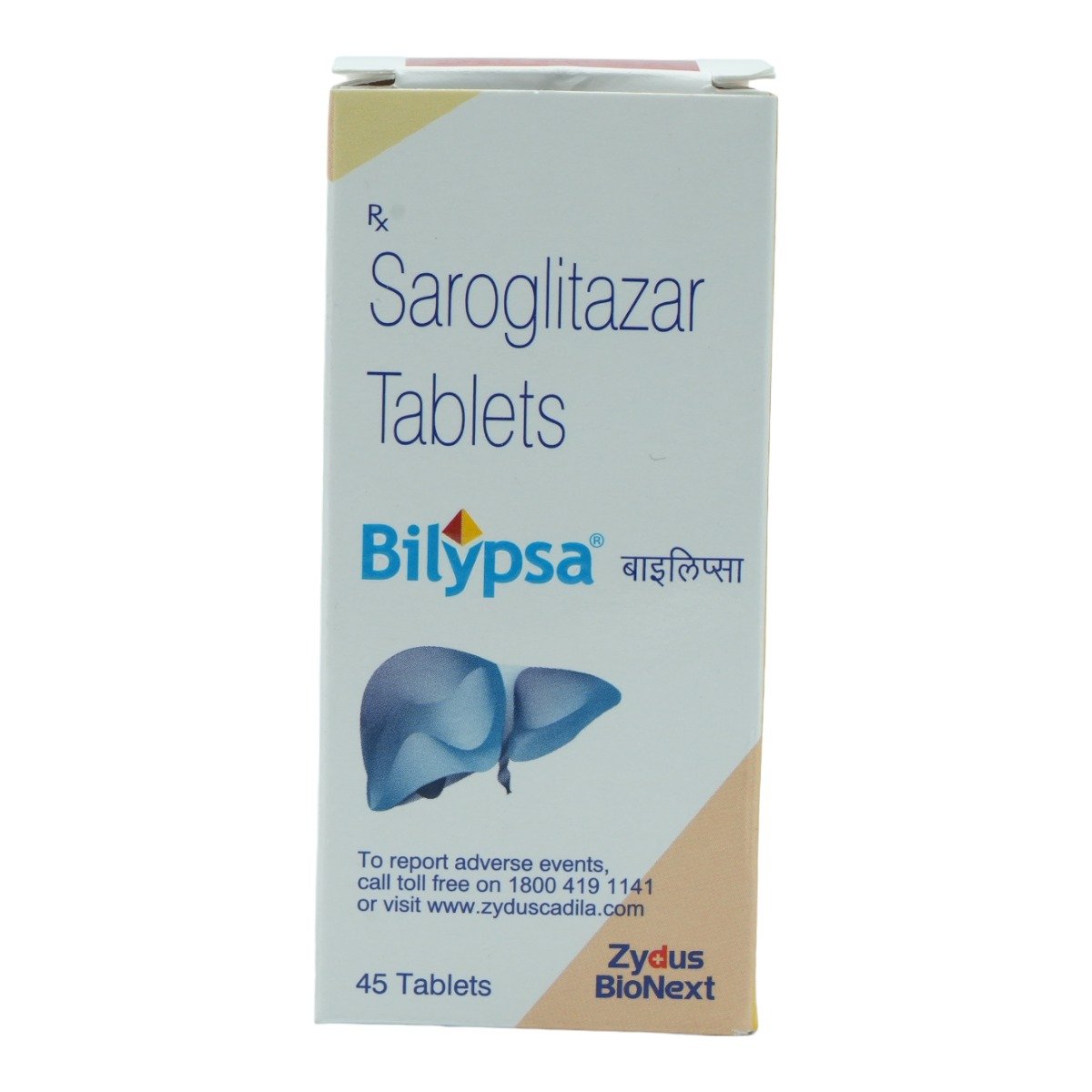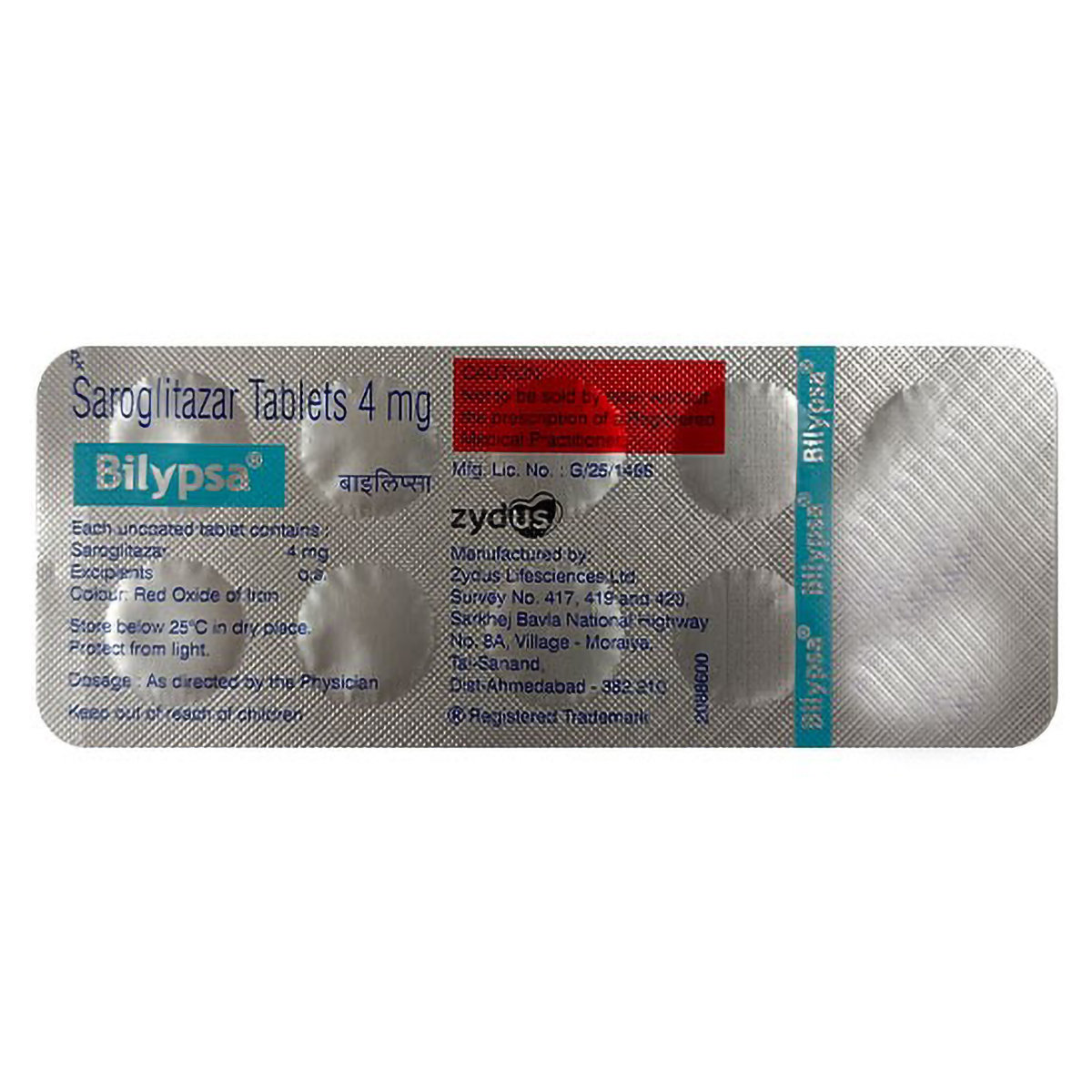Saroglitazar
About Saroglitazar
Saroglitazar is an insulin sensitiser used to treat diabetic dyslipidaemia/hypertriglyceridemia in type-2 diabetic patients, which is not controlled by statins (lipid-lowering agents) alone. Saroglitazar has both lipid and glucose-lowering effects in a single molecule; thereby, helps lower blood triglycerides and blood glucose levels. Diabetic dyslipidaemia is characterised by increased triglyceride levels, low-density lipoproteins (LDL) and decreased high-density lipoprotein (HDL) levels. This condition is common in people with type-2 diabetes mellitus.
Saroglitazar contains ‘Saroglitazar’, which has dual Peroxisome Proliferator-Activated Receptor (PPAR)-α/γ agonist having strong PPAR-alpha effect and moderate PPAR-gamma effect. PPAR-alpha reduces the synthesis and secretion of triglycerides, increases lipolysis and hepatic oxidation of fatty acids. It also induces an increase in the synthesis of HDL cholesterol. PPAR-gamma reduces the metabolic burden on the liver, muscle and promotes glucose utilisation. It improves post-absorptive insulin-mediated suppression of hepatic glucose output. Thereby, Saroglitazar helps in lowering blood triglycerides and blood glucose levels.
You are advised to take Saroglitazar for as long as your doctor has prescribed it, depending on your medical condition. In some cases, you may experience certain common side effects such as stomach inflammation, nausea, vomiting, weakness, chest discomfort, dizziness, and fever. Most of these side effects do not require medical attention and will resolve gradually over time. However, you are recommended to consult your doctor if you experience these side effects persistently.
Consult your doctor if you are pregnant. It is not known if Saroglitazar is excreted into breastmilk; therefore, nursing mothers should avoid taking Saroglitazar. Saroglitazar should not be given to children as safety and effectiveness have not been established. Saroglitazar should be used with caution in patients with kidney or liver impairment and in elderly patients. Avoid alcohol consumption while taking Saroglitazar as it might cause unpleasant side-effects. Saroglitazar might cause dizziness, so drive with caution. Inform your doctor about all the medications you are taking and your health condition to rule out any unpleasant side effects.
Uses of Saroglitazar
Medicinal Benefits
Saroglitazar is an insulin sensitiser used to treat diabetic dyslipidaemia/hypertriglyceridemia in type-2 diabetes, which is not controlled by statins alone. Saroglitazar has demonstrated reduction of triglycerides (TG), Low-Density Lipoprotein (LDL) cholesterol, non-High-Density Lipoprotein (non- HDL) cholesterol, Very Low-Density Lipoprotein (VLDL) cholesterol, and an increase in HDL cholesterol. It has also shown glycemic indices by lowering the fasting plasma glucose and glycosylated haemoglobin in diabetic patients. Saroglitazar has dual Peroxisome Proliferator-Activated Receptor (PPAR)-α/γ agonist having strong PPAR-alpha effect and moderate PPAR-gamma effect. PPAR-alpha reduces the synthesis and secretion of triglycerides, increases lipolysis and hepatic oxidation of fatty acids. It also induces an increase in the synthesis of HDL cholesterol. PPAR-gamma reduces the metabolic burden on the liver, muscle and promotes glucose utilisation, and improves post-absorptive insulin-mediated suppression of hepatic glucose output. Saroglitazar has both lipid and glucose-lowering effects in a single molecule; this helps in lowering blood triglycerides and blood glucose levels as well. It also helps in improving insulin resistance. Saroglitazar offers a superior safety profile, greater efficacy on lipid regulation, and excellent glycaemic control.
Directions for Use
Storage
Side Effects of Saroglitazar
- Gastritis (stomach inflammation)
- Nausea
- Vomiting
- Asthenia (weakness)
- Chest discomfort
- Dizziness
- Pyrexia (fever)
Drug Warnings
Do not take Saroglitazar if you are allergic to any of the components. Inform your doctor if you notice rapid weight gain. Consult your doctor before taking Saroglitazar if you are pregnant. It is not known if Saroglitazar is excreted into breastmilk; therefore, nursing mothers should avoid taking Saroglitazar. Saroglitazar should not be given to children as safety and effectiveness have not been established. Saroglitazar might cause dizziness, so drive with caution. Avoid alcohol consumption while taking Saroglitazar as it might cause unpleasant side-effects. Saroglitazar should be used with caution in patients with type-2 diabetes having cardiovascular disease.
Drug Interactions
Drug-Drug Interactions: No interactions found/established.
Drug-Food Interactions: No interactions found/established.
Drug-Disease Interactions: No interactions found/established.
Drug-Drug Interactions Checker List:
Safety Advice

Alcohol
cautionYou are recommended to avoid alcohol consumption while taking Saroglitazar to prevent unpleasant side effects.

Pregnancy
cautionSaroglitazar belongs to pregnancy category C. Consult your doctor before taking Saroglitazar if you are pregnant; your doctor will prescribe only if the benefits outweigh the risks.

Breast Feeding
unsafeNursing mothers should avoid taking Saroglitazar as it is not known if Saroglitazar is excreted into breastmilk.

Driving
cautionSaroglitazar may cause dizziness. Therefore, drive or operate machinery only if you are alert.

Liver
cautionSaroglitazar should be used with caution in patients with liver disease. Please consult your doctor if you have a liver impairment or any concerns regarding this.

Kidney
cautionSaroglitazar should be used with caution in patients with kidney disease. Please consult your doctor if you have kidney impairment or any concerns regarding this.

Children
unsafeSaroglitazar is not recommended for children as the safety and effectiveness have not been established.
Habit Forming
Diet & Lifestyle Advise
- Follow a cholesterol-lowering diet.
- Exercise regularly. It helps in maintaining proper weight and lowers cholesterol.
- Limit salt and sugar intake.
- Avoid smoking and alcohol consumption.
- Choose healthy fats and cut down on trans-fat.
- Include omega-3 fatty acids, fibre-rich food, fruits and vegetables.
- Get active by doing any physical activity such as swimming, brisk walking or jogging. Take stairs instead of elevators/lifts.
- Try eating food at regular intervals. Do not skip meals. Also, try not to overeat.
- Follow a healthy diet and walk for at least 45 minutes to complement treatment with Saroglitazar.
- Rest properly, avoid stress by doing meditation or yoga.
Patients Concern
Disease/Condition Glossary
Diabetic dyslipidaemia/hypertriglyceridemia: Diabetic dyslipidaemia, also known as hypertriglyceridemia, is characterised by increased triglyceride levels, low-density lipoproteins (LDL) and decreased high-density lipoprotein (HDL) levels. This condition is common in people with type-2 diabetes mellitus. It is one of the major risk factors for cardiovascular disease in diabetic patients. Lifestyle, genetics, obesity, consumption of high saturated/trans fat, low thyroid levels, and kidney disease could be the cause of dyslipidaemia. Symptoms of diabetic dyslipidaemia include chest pain/tightness, indigestion, heartburn, dizziness, palpitations, shortness of breath, cold sweats, nausea, and vomiting.
FAQs
Saroglitazar decreases triglycerides, LDL cholesterol and increases HDL cholesterol. It also helps in promoting glucose utilisation. Thereby, Saroglitazar improves insulin resistance, and lowers blood triglycerides and blood glucose levels.
Saroglitazar does not cause weight gain or oedema. However, inform your doctor if you notice rapid weight gain. Your doctor might assess you for fluid accumulation, volume-related events such as oedema and congestive heart failure.
Do not stop taking Saroglitazar without consulting your doctor. To treat your condition effectually, continue taking Saroglitazar for as long as your doctor has prescribed it.
Saroglitazar can be taken by elderly patients if prescribed by the doctor. However, Saroglitazar should be used with caution in geriatric patients.
Consult your doctor before taking Saroglitazar if you have cardiac problems. If prescribed, Saroglitazar should be used with caution in patients with type-2 diabetes having heart-related problems with episodic congestive heart failure. Regular monitoring for signs and symptoms of congestive heart failure in such patients is advised.






